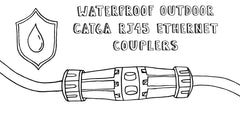Payment methods accepted

Q&A: Series 6 Coaxial Cable with Don and Dave
Are you shocked that we're back with another Q&A video?! This time around, Don and Dave answer questions about Series 6 Coaxial Cable. Want to learn more? Well...keep reading!
Don Schultz: Hey, there Youtubers. It's Don, Dave, and Mikayla coming back to you for another virtual Q&A session. This time, we're going to be talking about an oldie, but a goodie, Series 6 coaxial cable. You would think with something that's been around for so long that every possible question and answer in the world has been figured out for it. However, as it turns out, there's quite a few things that still come up about coax cable and there's new people that come into the industry over time. We're going to go ahead and Mikayla's going to ask some questions and Dave and I are going to do our best to answer them.
What is the meaning of Series 6?
Dave Harris: Series 6 coaxial cable is a new name for an old friend for most of us, RG6. There's a new nomenclature standard, or a new designation, for coaxial cable that drops the RG designation, which is now deprecated. What used to be called RG6 is now called Series 6 and what used to be called RG11 is now called Series 11. Same for RG59. It's now called Series 59. That's the new naming designation and that's the only difference between Series 6 and RG6 coax cable is the new name.
Can I use outdoor rated coaxial cable indoors and vice versa?
Don Schultz: Well, it depends and no. Really the discussion doesn't revolve around coaxial cable so much as it involves outside plant, or OSP cable, and how far you can bring that indoors on particular types of installations. The longer answer is CMX rated or outside plant cable may enter into a commercial structure, up to 50 feet, if not in conduit after which it must transition to indoor cable.
Or, there's an exception in a code for this, you can actually bring it in more than 50 feet, but it has to be in either intermediate conduit or really heavy RMC conduit where you screw it together. As long as the cable is sealed it may continue to run inside of a commercial structure, but it has to be continuous and sealed all the way to the point of termination. Normally, if you're not using that type of conduit to seal up the cable run, then 50 feet is your maximum. Now, there's also an exception made in the code for residential structures. Outdoor cable that's 1/4 inch or less in overall diameter thickness may be used in single or duplex dwellings throughout your entire structure, whether it's indoor or outdoor style. Obviously, if you have indoor coaxial cable or any kind of indoor cable, you should never take that outside because it's not UV stable and it's going to break down outdoors. But if you're going to be using it residentially, a single or duplex dwelling, coaxial cable of a 1/4 inch thickness or less, you can use all throughout the structure and outside, no restrictions. This is for most jurisdictions, of course, you should check your local codes to be sure. But more often than not, what I just said is going to apply for the entire United States.
It just so happens that our dual shield outdoor coaxial RG6 cable, our Series 6 cable, is actually of the proper diameter where in a residential setting, single or duplex type dwelling, you can go ahead and just use it wherever you want.
How is Series 6 coaxial cable terminated?
Dave Harris: There are three different types of connectors that are normally associated with Series 6 Cable. The first is F connectors which are the threaded type that you usually find on the back of a television set or back of a cable modem. The second is BNC connectors which are a twist lock type of connector that is often found used in component video. The third is RCA connectors, which are a push-pull-type connector, normally used in audio connections.
Compression style and crimp on style are acceptable, although compression style connections are much preferred. Twist on type of connectors are no longer acceptable. As far as the actual nuts and bolts of how to do the termination, we have multiple blogs on our website that address how to do this with pictures and even videos. So tune in for those.
How long of a distance can Series 6 coaxial cable be used and will Series 11 coaxial cable go farther?
Don Schultz: Series 11 will go farther, however it depends on the application. Of course, the most common application these days is broadband. That would be for cable TV and satellite TV. Whether it's Series 6 or Series 11 is going to define how far you can take it because Series 11 is a much heavier duty cable.
Let's gloss over the distance limits. From powered device to powered device, the entire channel, Series 6 can reach 184 feet. That's inclusive of all RG6 or Series 6 cable. You have two patch cords at the outlets on both ends that are
capable of being 17 feet long. Then you have a middle link that is 150 feet long. So basically, outlet to outlet is 150 feet. Then you add on the equipment cords at both ends of the link and you're at 184 feet permissible. That's the same for either cable TV or satellite TV. When it comes to Series 11, your distance can jump to 328 feet from power device to power device. Essentially that's a 295 foot link from outlet to outlet, that's constructed entirely of Series 11 coaxial cable.
The remaining 32 feet of permitted cable would actually be Series 6 for use inside the room. That would be used at both ends of the link for equipment cords. So, outlet to outlet with Series 11 is 295 feet and then you've got another 32 feet or essentially 16 feet at each side of Series 6 that can be used for in the room, patching connections, things like that. So really Series 6 serves most indoor purposes well, however, when you're doing long haul outdoor runs, oftentimes you'll see Series 11 used.
How is Series 6 coaxial cable different from Series 11 coaxial cable?
Dave Harris: Well, it's really just a difference in size and current carrying capability with a few other differences in there. Essentially, I think of RG59 as wimpy. I think of RG11 as being really strong. And I think of RG6 as just right.
Don Schultz: Another big difference between Series 6 and Series 11 is that Series 11 is literally about half an inch thick. It's heavy and difficult to work with. If you had to compare it to something else that you might find outside in your yard, frozen garden hose in the middle of winter would probably be the the right term to apply to Series 11 coax cable. So, to sum it up Series 11 is very heavy, expensive, and difficult to work with but it gets you a longer distance. So that's another really big difference between those two.
Is coaxial cable becoming obsolete?
Don Schultz: For many years in industry there have been many pundits and technicians that have been predicting the ultimate doom and death of coaxial cable. But thus far it's proven really difficult to kill it off and for good reasons. New businesses have been wired with fiber optic for a while for Internet connections. But new construction residential is often fiber optic now but you have to take into account that there is a whole lot of older homes out there that have been erected and have coaxial cable running to them. They are always going to be there. With that being said there's a huge amount of coaxial still installed and if it's installed and working, it has to be maintained. So it's always going to be for sale at least for the next at least 50 years.
Also, there's a new development, which is 10 Gigabit Internet speed on download, over coaxial cable. So that's going to extend its life yet further. So now you're going to be able to get coaxial cable connections, at least on the download speed, to match some of the fastest fiber that's out there. So the answer is no. It's really not becoming obsolete.
Is quad shield or dual shield coaxial cable better?
Dave Harris: Well, it depends on what you want to use it for. Quad shield coaxial cable has more shielding so it's better for shielding against electromagnetic interference. Same thing you use shielding for in a shielded Ethernet cable. So if you are installing your coax cable in an environment where there's lots of electromagnetic interference, you will want to opt for quad shield cable, just like you would opt for shielded cable if you were using Ethernet Cable. So it just depends on your application.
Why can coaxial cable not be used for high-speed Ethernet connections like with copper twisted pair category cable.
Don Schultz: Technically speaking, you could use coaxial cable to achieve high-speed Ethernet connections. However, not in a cost-effective manner. You see, coaxial cable has only one singular conductor circuit where Ethernet cable has four. I don't mean individual wires, I mean, conductor circuits. So it's easier to achieve higher bandwidth with more conductor circuits. Also, with electromagnetic balancing. It makes for a less heavy cable to achieve the same rate of speed. I would hate to think what the required coaxial cable would be in order to achieve 10 gigabit networking. It's also a matter of cost-effectiveness. If you try to achieve a modern networking speed with coaxial you would also require much more expensive equipment. Right now you can pick up an Ethernet NIC if you need to add one to your computer for like $15. The equivalent device to support coaxial would cost considerably more and so it's a matter of heat, cost, and cable thickness. So all of those things combined basically put coaxial cable for inside networking sort of in into the outfield. In other words, it sort of put it into the background and then it just sort of disappeared. Now we use twisted pair category cable for modern networks.
What is CCS and is it inferior to solid copper? Where is CCS appropriate, and where must solid copper be used? Are their installations different?
Dave Harris: Yes, CCS stands for copper clad steel which means that the center conductor in this type of coaxial cable is essentially made of steel with a copper surface bonded to it. The copper surface is where the actual signaling takes place in a phenomenon called the skin effect.
Why use copper clad steel? Well, when installing it you can pull it harder because it's essentially stronger. But when installing it you have to have special tools for doing something as simple as cutting it. Normal copper cable cutters will quickly be destroyed when used on steel wire. When it comes to performance CCS and solid copper are actually similar in performance. Performance wise, there isn't a reason to choose one over the other. As we talked about there are some installation differences. As a chemist myself I know that talking about steel, if there's just a little bit of water and a little bit of oxygen present, like air, it's going to corrode and it's going to corrode really fast. I would choose not to use copper coated steel just for that reason.
Don Schultz: Where solid copper really shines over copper clad steel is the ability to handle PoE and DC voltage. The problem with copper clad steel is that electricity to power up something like a dish for example, is going to peter out or attenuate really quickly and under power or under volt your end equipment. That could cause it to be damaged. At the very least it's probably going to cause it to be unreliable, not work at all, or literally be damaged because it's been undervolted. Solid copper doesn't have that problem. It handles data transmission just as well, but it also handles DC voltage. It's so critical for example, satellite installation. So, technically speaking, you shouldn't be using anything other than solid copper coaxial in a satellite installation. There's not any real advantage to copper clad steal other than saving a few dollars.
Don Schultz: Hopefully you enjoyed this Q&A session talking all about coaxial cable and some of the various types and what is suitable for what. Hopefully, we answered some questions. We did our best to address maybe some more off the wall questions that we get in the Q&A sessions that we didn't necessarily write about in our blogs. We do have quite a few blogs, though, in our cable academy that you can go and look at that have videos about terminating and working with coaxial cables. So I recommend you head over at our cable academy and give those blogs a look.
Happy Networking!!
trueCABLE presents the information on our website, including the “Cable Academy” blog and live chat support, as a service to our customers and other visitors to our website subject to our website terms and conditions. While the information on this website is about data networking and electrical issues, it is not professional advice and any reliance on such material is at your own risk.


































